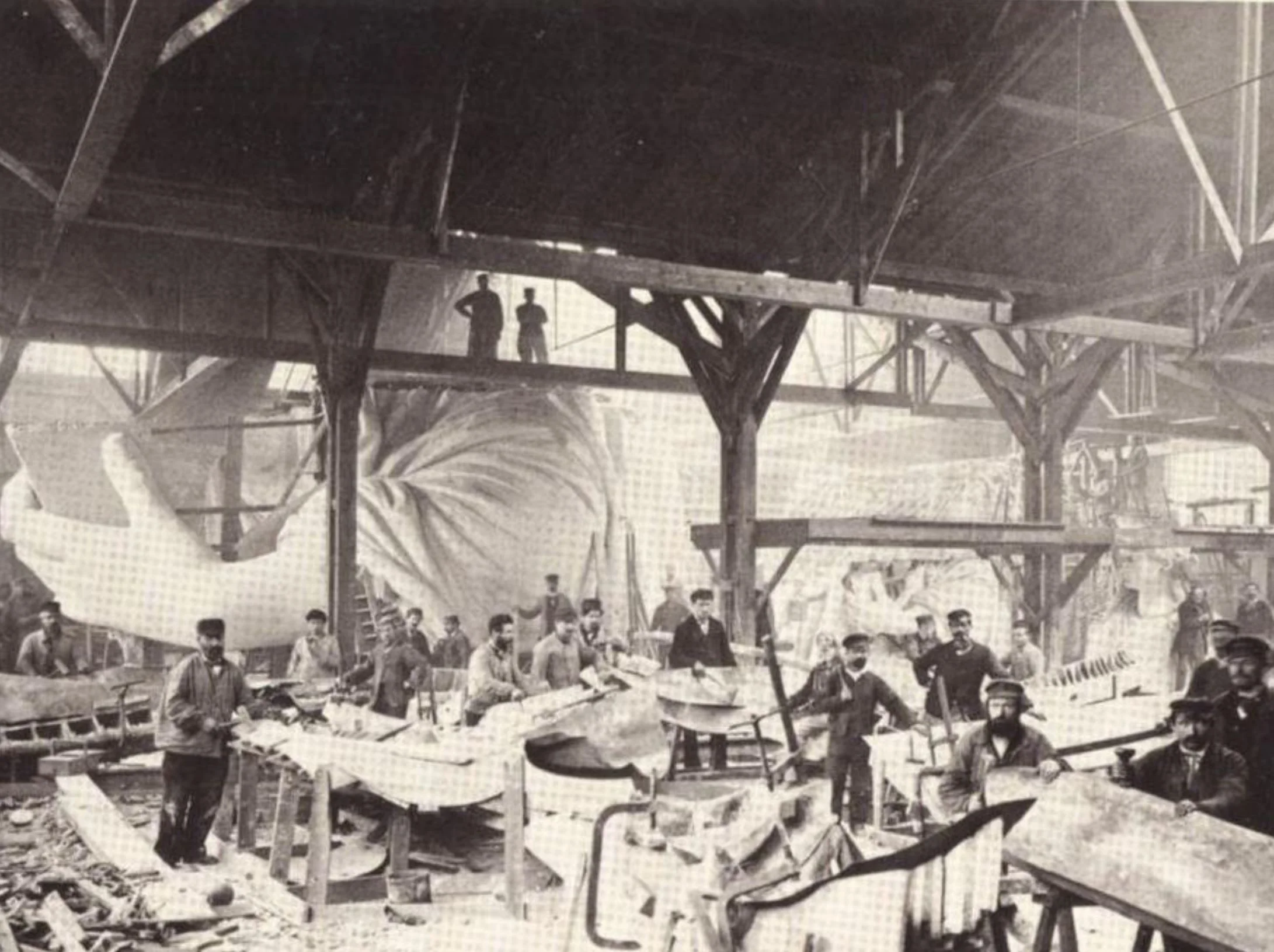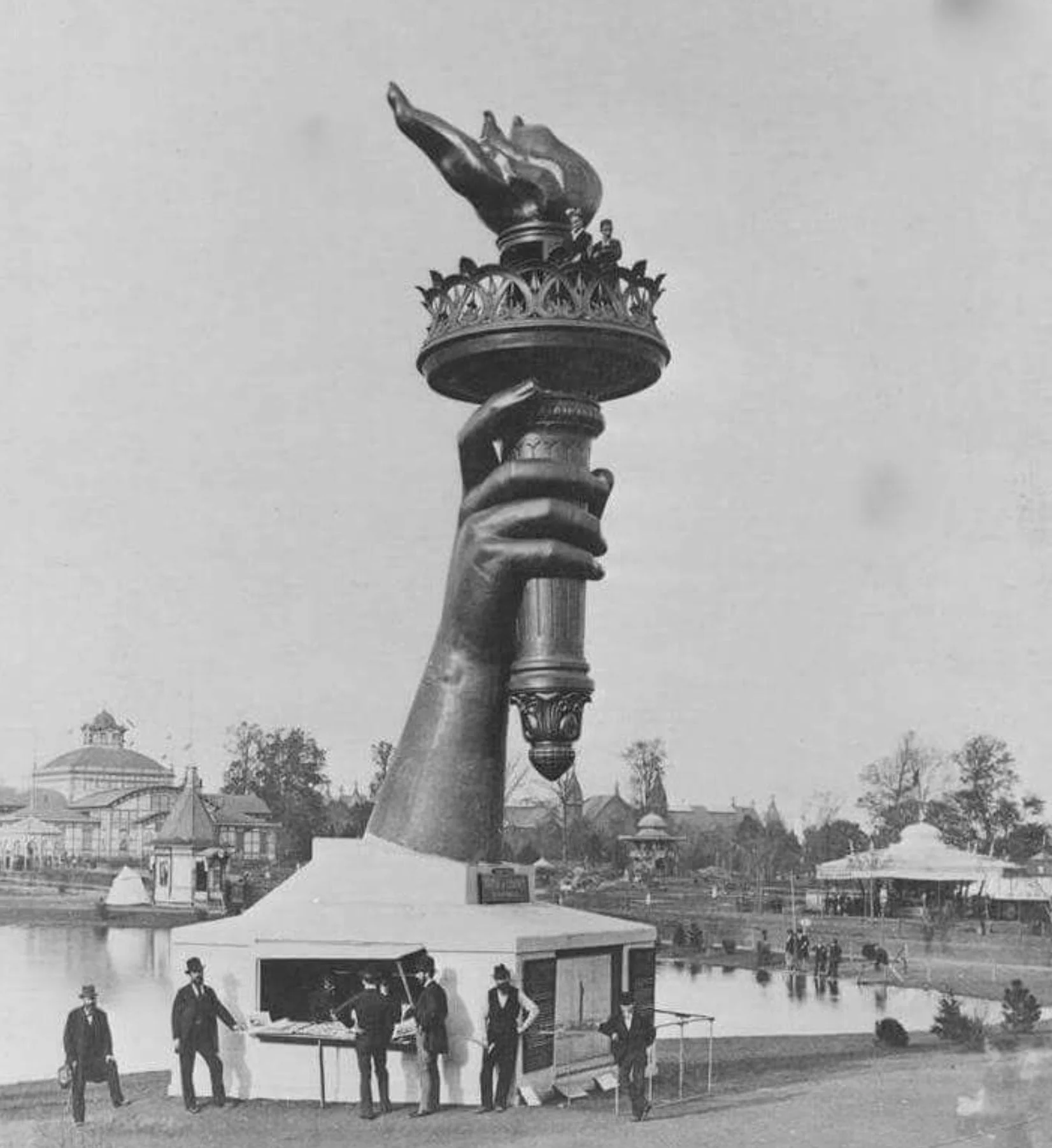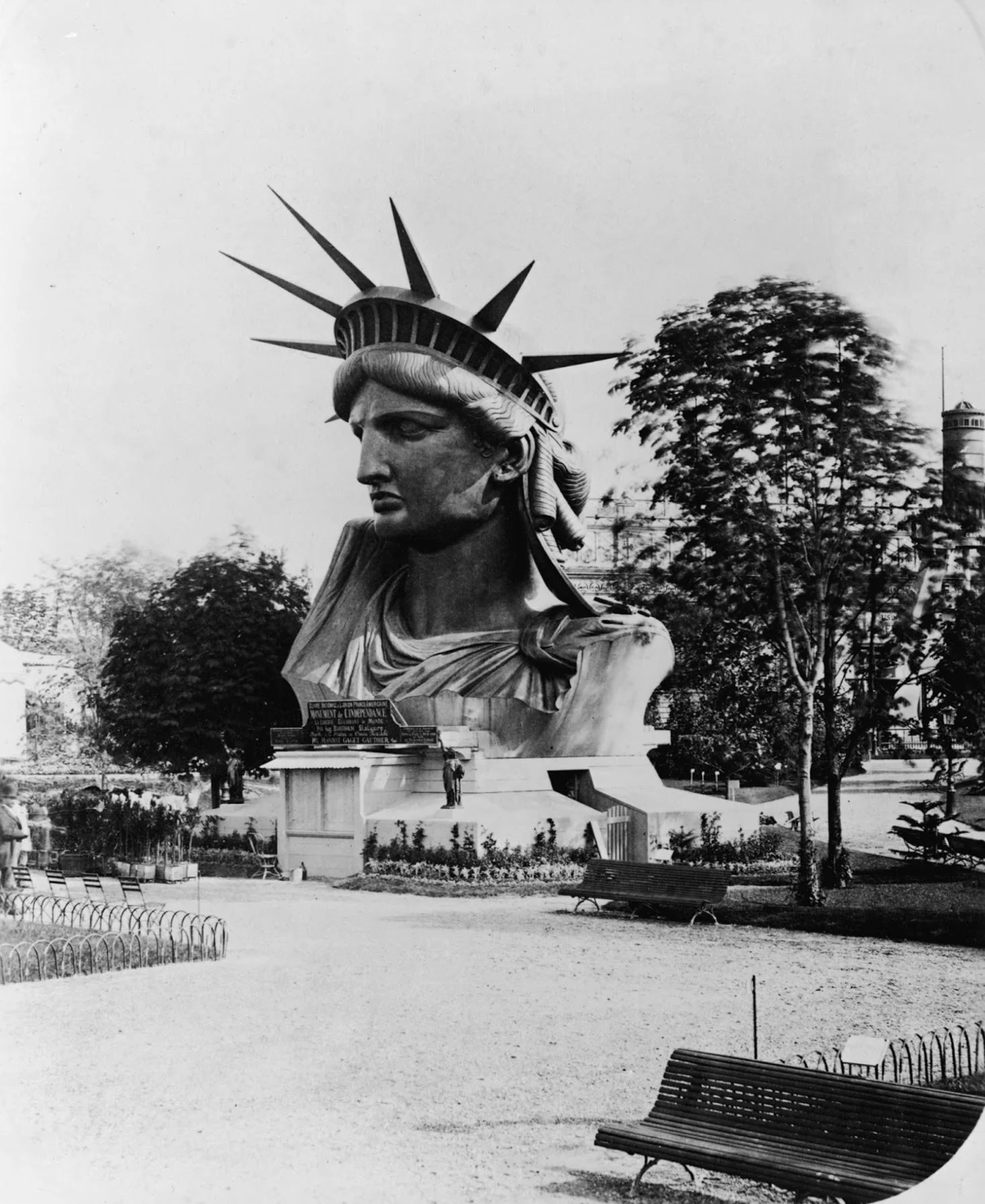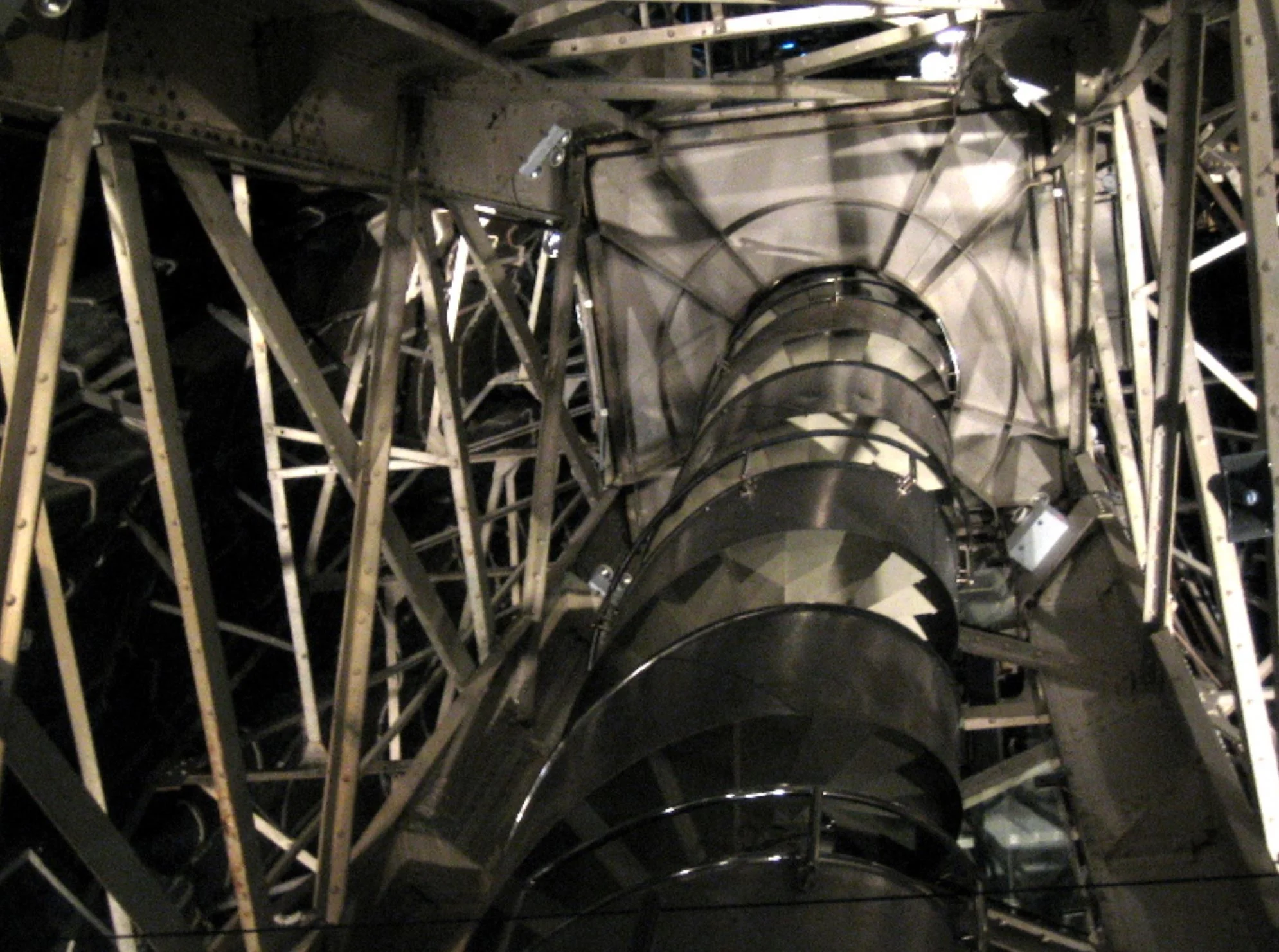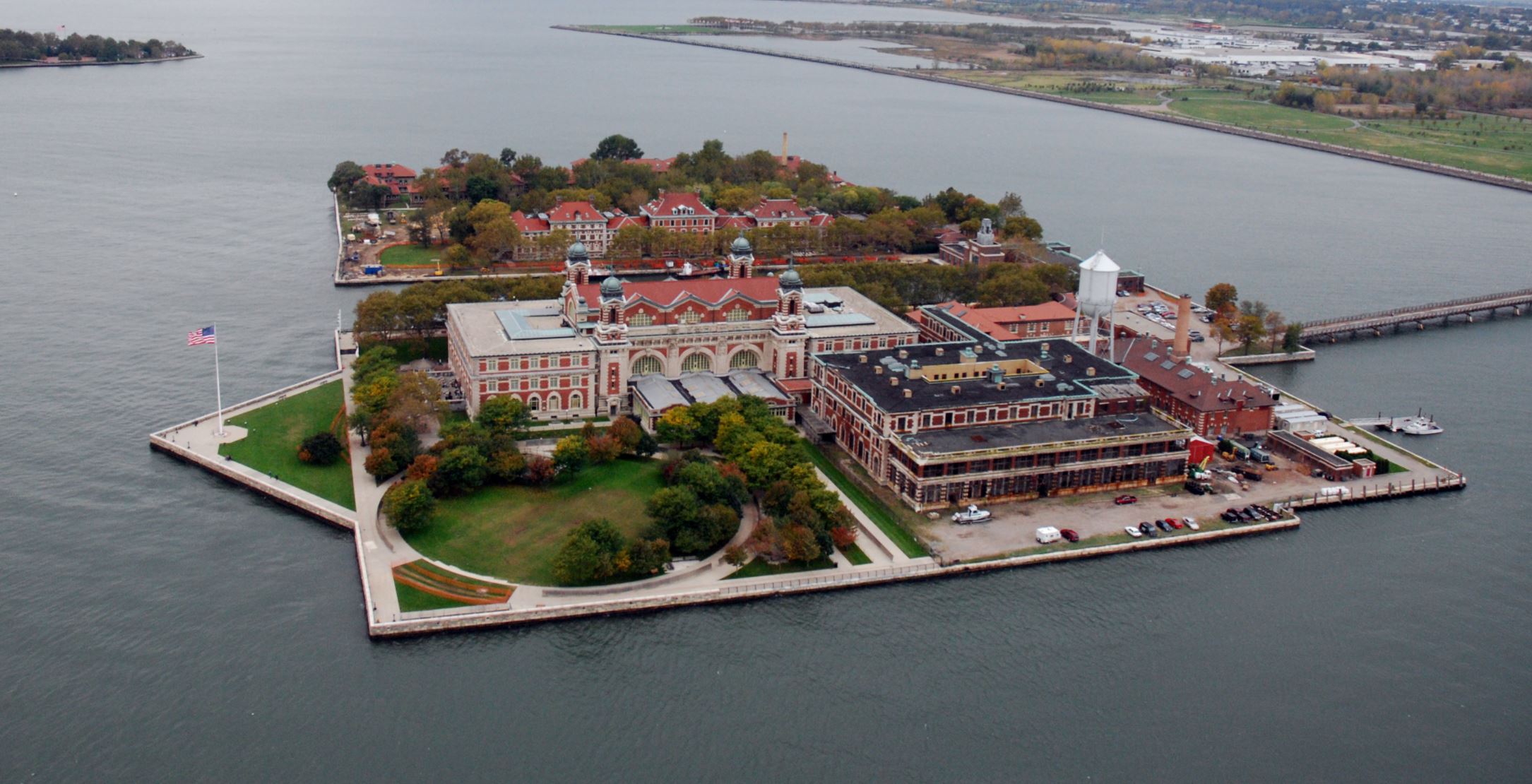The Statue of Liberty.
The New Colossus
Not like the brazen giant of Greek fame,
With conquering limbs astride from land to land;
Here at our sea-washed, sunset gates shall stand
A mighty woman with a torch, whose flame
Is the imprisoned lightning, and her name
Mother of Exiles. From her beacon-hand
Glows world-wide welcome; her mild eyes command
The air-bridged harbor that twin cities frame.
“Keep, ancient lands, your storied pomp!” cries she
With silent lips. “Give me your tired, your poor,
Your huddled masses yearning to breathe free,
The wretched refuse of your teeming shore.
Send these, the homeless, tempest-tost to me,
I lift my lamp beside the golden door!”
- Emma Lazarus, 1883
Seen off the coast of Redhook, Brooklyn, stands Lady Liberty herself, a centerpiece of New York Harbour and on her own Liberty Island. A gift from the people of France after the American Civil War, she stands with a torch in her hand, a beacon for the immigrants of a century ago to light their way to America as they came by ship across the Atlantic waters. The Statue of Liberty is clearly seen from the shores of Brooklyn and plays an incredible role in the people’s identity. In this article, I will discuss relations with France, the building of the statue, and the impact of Lady Liberty on New York City and American values.
The People of France designed, built and assembled the Great Statue
Construction is remarkable feat by combining art, engineering and scale
Lady Liberty has been a symbol of Freedom and Welcome, identifying with Americans and demonstrating willingness to accept those in need
Firstly, the Great Statue was a gift from the people of France. After the American Civil War (1861-1865), French and American politicians began discussions of building a monument commemorating the 100th anniversary of the Declaration of Independence. The French have held diplomatic friendship since they aided the Americans in securing their freedom in the American Revolution, and the French followed suit with their own revolution in France. The peoples of these countries have shared a strong belief in individual Freedom and resistance to tyranny, and have worked together to spread ideas, deal together in business and aid each other in war.
Edouard de Laboulaye proposed the idea of a liberty monument for the United States in 1865. A decade later, Frederic Auguste Bartholdi aimed to actualize the idea, and the sculptor was commissioned to design the sculpture. The agreement was for the United States to provide the land and the pedestal, and France would build and assemble the statue. Honoring the American Declaration of Independence, he proposed a statue of “La Liberté Éclairant le Monde” (“Liberty Enlightening the World”) as the centennial gift. He imagined the Roman goddess of liberty, Libertas, raising a torch in one hand, a tablet in the other hand with the inscription, “JULY IV MDCCLXXVI”, and broken chains at her feet. Bartholdi and his team would sculp all the plates in his massive workshop in France [1].
The French and American committees decided to set the statue in New York City, a reasonable location due to its political importance and accessibility to the Atlantic Ocean. The fort on Bedloe’s Island, Fort Wood, would be the base of the statue. This fort was built to guard the harbor during the War of 1812, and inactive ever since. The structure was demolished, and the foundation used for the pedestal. The island would be renamed Liberty Island. However, although the goal was to start the project in 1875 and finish in 1876, the construction was constantly delayed due to lack of funds. Through many forms to raise money, largely led by the publisher of New York World, Joseph Pulitzer, the pedestal was eventually completed. One must also acknowledge Emma Lazarus who wrote the poem, The New Colossus, which raised substantial money for the pedestal in 1883 and was eventually placed on the pedestal as a plaque in 1903 [2].
After waiting for years to start assembly, the statue began her journey to New York in April of 1886. The French had completed all three-hundred-fifty plates by 1884 and actually stood completed in Paris. The statue was made of copper, and engineer Alexandre-Gustave Eiffel was hired to design the internal support to make construction and sustainability possible. He is the man who engineered the Eiffel Tower in Paris (which was meant to be a temporary piece, but the Parisians identified with the tower so much, they would not take it down). In order to keep the hollow copper statue in place from high winds, he would construct an iron tower firmly attached to the pedestal and attach the copper frame to structure. The iron tower (similarities to the Eiffel Tower) would act as the skeleton for the structure and would make the inside a cathedral to behold of the marriage between art and engineering [3]. In a single trip, all of the pieces were shipped on the frigate, Isère, in two-hundred-fourteen crates on train and across the ocean from France. And when they arrived, the pieces would be put together like a puzzle with few engineering issues [1].
Since then, the Statue of Liberty has stood on her island, and holds a close connection to Ellis Island and immigration. She has made a point that the United States of America is a land of maximizing Freedom. And when the People can, they want and will accept those of good heart and in need. It’s unfortunate that travelers no longer ride a ship into the harbor to witness the statue as they enter the threshold of the American dream, but a free ride on the Staten Island ferry could substitute the experience and provide an excellent view off the edge of your boat.
By Nick Borak
Places to Visit
Statue of Liberty - Liberty Island
The monument stands on an island in the harbor, and a boat and tickets are needed to get up close to the structure. Grab tickets because reservations are recommended.
https://www.statuecruises.com/#/
Ellis Island
A historical island in New York Harbour, where a significant number of immigrants passed through on their way to establish themselves in America.
https://www.statuecruises.com/#/
Redhook - Brooklyn
A tip of Brooklyn where the Statue of Liberty and Downtown Manhattan can be viewed from the waterfront.
Staten Island Ferry - Manhattan or Staten Island
Take a free MTA ferry between south Manhattan and Staten Island which gives unique views of the Great Statue and New York City from the water.
(Another) Statue of Liberty - Paris, France
There is a miniature Statue of Liberty in Paris, commemorating the participation of France in the monument creation and union between countries.
Sources
[1] “Statue History.” Liberty Ellis Island. The Statue of Liberty - Ellis Island Foundation, Inc. 8 March 2018.
https://www.libertyellisfoundation.org/statue-history
[2] Santoso, Alex. “The True Story of the Statue of Liberty.” Neatorama. NeatoCMS. 8 March 2018.
http://www.neatorama.com/2007/05/31/the-true-story-of-the-statue-of-liberty/
[3] “History of the statue of Liberty.” Wonders of the World. 8 March 2018.
https://www.wonders-of-the-world.net/Statue-of-Liberty/History-of-the-statue-of-Liberty.php
DISCLAIMER: Most information is acquired by surfing the internet, reading books and watching documentaries. We try to give credit where credit is due. If you find an error or issue with the content, please contact us so we can try to verify and edit the information.



